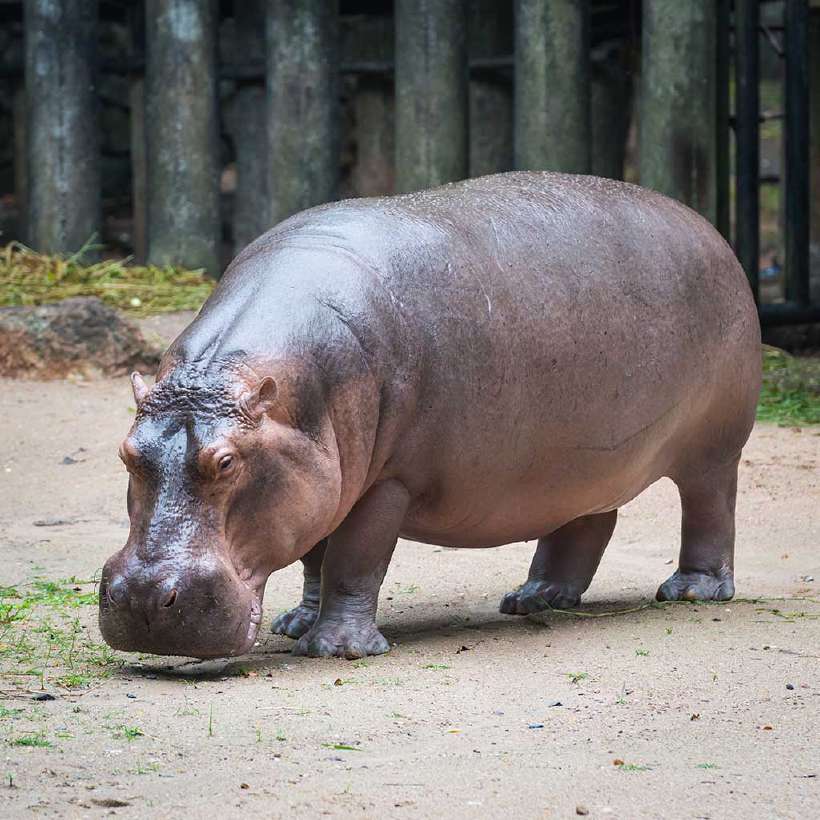Why is a Hippopotamus called a River Horse?
Home / Science for Kids / Planet Earth for Kids / Why is a Hippopotamus called a River Horse?
Among Africa’s unusual creatures is a barrel-shaped gigantic animal, the hippopotamus (plural hippopotami). The hippo is the third largest land animal after the elephant and the rhino. Slightly smaller but heavier than a white rhino, a hippo can weigh nearly 1,800 kg. The animal is huge and barrel shaped nearly 12 feet long and five feet at its shoulder, with a short thick neck and small ears.
![River Horses [Illustration by Anup Singh]](/media/earth-98_1_hu8944fca74aa5e9a6d5fb886c7b08249b_8089_820x0_resize_q60_box.gif)
Hippos, or to use their biological name, hippopotamus amphibious literally means ‘river horse’. Recent DNA (a test for genes) has revealed that the hippo is more closely related to cetaceans (whales and dolphins) than to any other artiodactyls (even-toed hoofed mammal).
Hippos are hoofed vegetarians, feeding on grass, fallen fruit, and occasionally on cultivated crops such as sugar cane or corn during the night.
Hippos prefer rivers with deep water and nearby reed beds and grasslands, but are also found in salt-water areas near river mouths. They are well- adapted to stay in water and are excellent swimmers. Their ears and nostrils located at the top of the head – close automatically when the animal is under water.

These animals prefer to stay in water through the day coming out only at night to forage for food. This search for food may take them five miles inland and so they liberally mark the path with their dung and urine to help them find their way back home before dawn.
Adults may consume about 100 pounds of grass cutting the grass off with their broad lips and not with their teeth like most grazers.
Hippo hide has practically no hair, and its smooth skin is quite delicate exuding a red, oily liquid that keeps the skin moist and protected when it is out of water. This has often led first-time explorers to arrive at the mistaken assumption that hippos sweat blood.
Hippos have large tusk-like incisors and canines that grow continuously. These tusks are of ivory, and even more valuable than an elephant’s because they do not turn yellow with age. It is a fact that US President George Washington’s false teeth were carved from the tusks of a hippopotamus and not made of wood, as is commonly believed!
A hippo has the widest jaws on any land mammal and when it opens its mouth to yawn the mouth measures two feet across! But despite its size and bulk, a hippopotamus can easily outrun a human.
A hippo herd usually contains ten to fifteen animals consisting of a dominant male, a few subordinate males, and several females and their young.
One calf is born at a time, after a gestation of around 230 days. Births usually occur in months of heavy rainfall, but can occur year-round. Young hippos will also bask on their mother’s back. Young males often form separate “bachelor” groups along the outskirts of the main herd.
The hippo’s present-day range is confined to sub-Saharan Africa. In ancient times, hippos were found as far north as the Nile delta. In fact, images of the hippopotamus are fairly common in ancient Egyptian art. Today, its range is restricted to the lakes, rivers, and swamps of East and central Africa.
Most claim that hippos are docile creatures while others maintain that hippos are aggressive, short-tempered beasts. Nearly all African explorers and hunters – Dr Livingston, Stanley, Burton, and Selous, etc – have had boating mishaps with hippos, though it is not known if they provoked the hippo.
Hippos are also extremely protective of their young and there is no animal more dangerous than a hippo if you happen to come between it and their young.
However, the hippo does give ample warning with an ear-splitting bellow like the roar of a lion and by opening its mouth in a huge yawn. The hippo’s yawn is not a sign of sleepiness or boredom but is actually a threatening gesture. A single bite can snap a small boat in half.
Unfortunately the hippo is poached both for its ivory tusks and for its skin. Rawhide whips are made of its skin while the tusks fetch a hefty sum in the black market.
700 words |
7 minutes
Readability:
Grade 8 (13-14 year old children)
Based on Flesch–Kincaid readability scores
Filed under: planet earth
Tags: #rivers, #africa, #horses, #hippopotamus, #teeth, #tusks
You may also be interested in these:
Escape to Freedom
Creating Light from Garbage
What Kind of Creatures are Sharks?
What Kind of Horses did Knights Ride?
The Elephant's Nose